| Name | Gills Iris Forceps |
| Lead Time | Lead time advised within 48 hours of order placement. |
| Competitor | ;355119;355-119;601510;60-1510;6015-10;OP3424;355126;355-126;601511;60-1511;6015-11;6015-10_6015-11; |
| Specialty | Ophthalmology-Stainless Forceps |
| Material Finish | Stainless Steel |
| Grade | Premium Operating Room |
| Units of Measurement | Each |
| Manufacturer | Medicrest Surgical Industries |
| Sterility | Non-Sterile |
| Usage | Reusable |
Gills Iris Forceps
slight curved, 2-3/4″ (7.0 cm)Gills Iris Forceps are a specially designed tool for handling iris tissue during ophthalmologic procedures. These delicate forceps have rough serrations lending the surgeon a firmer grip of the tissue. The forceps also feature a model with 1×2 teeth that drop below the level of the shaft upon closure, causing minimal protrusion.
SKU:
MSI-05-1119
Category: Forceps
Description
Reviews (0)
Be the first to review “Gills Iris Forceps” Cancel reply
Shipping & Delivery
Related products
Arruga Capsule Forceps
Bergh Cilia Forceps
cross-serrated tips, delicate, 3-3/8" (8.6 cm) Bergh Cilia Forceps are a multipurpose instrument for ophthalmologic procedures involving the eyelid. The forceps feature a serrated jaw that can be used for removing the cilia for trichiasis or management of blepharitis marginalis. The heavy spring pattern gives the surgeon increased power during the operation.
Bishop-Harmon Dressing Forceps
1x2 teeth, 3-3/8" (8.6 cm) Bishop-Harmon Tissue Forceps are a commonly used tool in a variety of ophthalmologic procedures. The forceps are designed for grasping delicate tissue in a small surgical field. Three finger holes on the handle allow the surgeon to adjust his or her grip during the procedure as desired. The forceps are available in straight or curved styles depending on surgical preference.
Castroviejo Fixation Forceps
wide handle, w/ out platform, 1x2 teeth, 4-1/8" (10.5 cm)Castroviejo Fixation Forceps are a useful tool in a variety of ophthalmologic procedures. The toothed design aids in the grasping and handling of the conjunctiva and episcleral tissue. In addition, the forceps may be used to hold the globe in place, aiding in other surgical maneuvers. Two different tooth sizes are available on the forceps depending on surgical preference.
Castroviejo Suture Forceps – Delicate
wide handle, delicate, 1x2 teeth w/ tying platform, 4-1/4" (10.8 cm) Castroviejo Suturing Forceps are a multipurpose tool for a variety of ophthalmologic procedures. The delicate teeth are designed for the handling of fine tissue, such as corneal tissue during a keratoplasty. The forceps are available with a tying platform, designed to grasp both the tissue and suturing equipment without changing instruments. Five different teeth sizes are available depending on surgical preference.
Catalano Micro Tying Forceps
round handle, 6.0 mm platform w/ cross-serrations at tip, 4-1/2" (11.4 cm)Catalano Micro Tying Forceps are an ideal tool during ophthalmologic procedures and post-operative care. The micro profile along with cross serrations are ideal for gripping suturing equipment as well as delicate tissue. The extended length allows access to difficult to reach areas, while the round handle is designed to reduce physician fatigue during the procedure. The forceps are available angled or straight depending on surgeon preference.
Colibri Titanium Forceps
angled tipsColibri Titanium Forceps are an excellent instrument during corneal surgery. The curved tip aides in grasping corneal tissue with minimal trauma or crushing, and are also useful for corneo-scleral suturing. Two different working lengths are available with the forceps depending on surgical preference. Forceps manufactured with a lightweight, titanium alloy body offer advantages for procedures that require delicate precision. They possess greater strength and durability than stainless steel and superior resistance to corrosion, staining and pitting. Titanium forceps are almost half the weight of stainless steel, offering a more tactile feel with minimal fatigue. Finally, blue-colored tint reduces glare and the non-magnetic material resists static buildup.
Ehrhardt Lid Forceps
14.0 mm oval lower plate, straight 9.0 mm serrated upper jaw, 4" (10.0 cm)Ehrhardt Lid Forceps are a tool used to expose the upper fornix of the eye. The forceps are commonly used to doubly evert the upper lid to gain more access to the upper fornix for examination or to retrieve foreign bodies. The forceps feature a serrated upper jaw designed to give a sure grip of lid tissue.

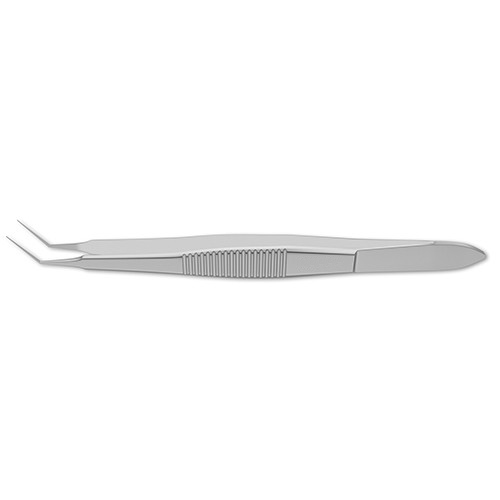
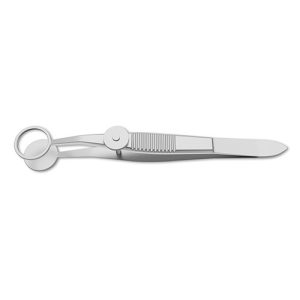

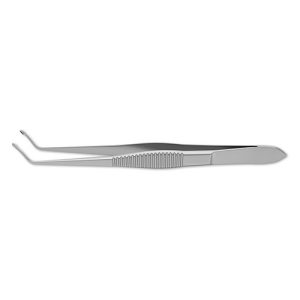
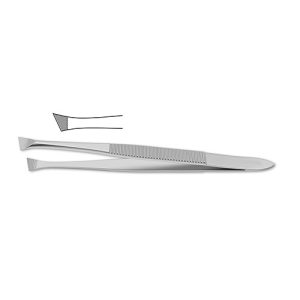
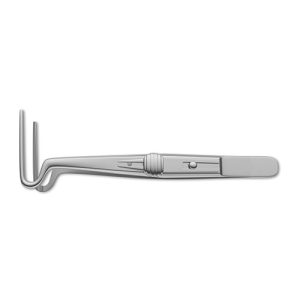



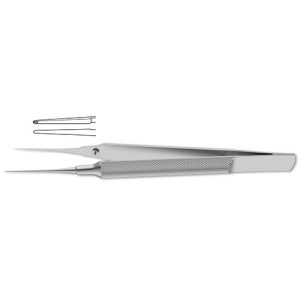


Reviews
There are no reviews yet.